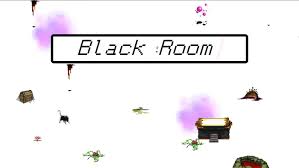“Imagine you are in a black room. Inside of the black room is a black table. Next to the black table is a black chair. Beside the black chair is a black vase.”
If you can imagine squeezing your eyes tight enough to see apparitions, you basically get the gist of “Black Room,” a 2017 free-to-play indie game by Cassie McQuater. I stumbled onto this game by accident by looking at the winners of the 2019 Independent Games Festival — and encountered the nonsense of trying to hang onto reality while descending deeper into the same dream, a bit different every time, over and over again. “Black Room” invites the player to “close your eyes and imagine a place you feel safe” and accompanies them as they realize they can only hold onto the comfort for so long.
This free-to-play game’s core mechanics are simple. It starts submerged in an unfamiliar world, as you, the first-person protagonist, are plunged into the browser-based fever dream of falling asleep at your computer with hundreds of tabs open. As your pixelated avatar walks through post-apocalyptic chaos, with acid rain and burning oil barrels, you find yourself in the titular black room. This room takes on the form of the famous Ames optical illusion where what you are seeing is not the real shape of the seemingly ordinary room, but a tangle of carefully constructed geometric lines. Embedded in the game mechanics is also the need to size and resize the proportions and boundaries of the room to find hidden objects, as everything around you dissolves. Throughout, the game prompts the user to hang onto what they think is real, to what they think is grounding them through the changing scenes. For those of you who’ve seen “Inception,” the onion folds of dreams within dreams make for a whole lot of confusion about what is real and what is constructed, as your pixelated character alternates between sensory deprivation and sensory overload.
The goal of the game then becomes searching for the objects that will move you along to a new manifestation of the black room, uncovered only by compressing and expanding your browser windows. With each subsequent stage comes a new browser window, each with embedded ASCII figurines of naked female forms, rooms with objects you need to destroy and rats and rat-like creatures that lead you into worlds of 8-bit leather succubus-dominated dumpster fires (with the occasional tractor?). One object, a clickable mirror, leads you to a Google search of “paradise.” Another leads you to a green screen of clickable YouTube links, each with animated “stock” videography of walls breaking, balls falling, paper being ripped: all found objects placed strategically in McQuater’s fascinating and disorienting dream world.
My favorite pieces of the game as I went through the levels were the easter eggs that my roommate (who I recruited to accompany me on this journey) and I were able to find. Though the mechanics of the game were simple and perhaps cumbersome at times, the true beauty of “Black Room” was in the pace being set by the player. Avid completionists have posted videos of full run-throughs of the game, which takes about two hours to truly soak in everything, but you as a player can experience the game on your own time — and return to where you left off by simply saving the browser.
The game is not light in its commentary about the commodification of women, about the end of the world and about the disassociation, lack of belonging and insomnia that inspired McQuater to create this game. This is present in the hyperlink name, a collection of letters chosen by banging a keyboard screen that McQuater calls a protest around the commodification of content by online search algorithms. Proclaimed a “feminist dungeon crawler,” there is a fundamental sense of nostalgia in the pixelated sprites being presented, like a strange, sexy “Warioware.” If it sounds confusing or overwhelming . . . that’s because it absolutely is. The game itself (like many indie games) pushes the boundaries of what is considered a game, putting forth a linear narrative that is both choose-your-own adventure but also highly consistent. If there is one thing I have to say about the game (beyond the overview that does not even begin to capture the full range of experiences one can have in this game), it is that those who identify as completionists and easter egg hunters might find the patterned mechanics a bit underwhelming and repetitive. The circular nature of the game that draws the player into the “Black Room” time and time again became (by the end of an hour) sensory overload, which is perhaps the point. By the end of the game, I no longer was focusing on the tremendous amount of detail and work put into each room — but on escaping the fever dream of the dozens of browser windows I had clicked through, knowing what awaited me behind each click. Photo credits: (Screenshots from “Black Room“ by Cassie McQuater)
Contact Julie Fukunaga at juliefa ‘at’ stanford.edu.
